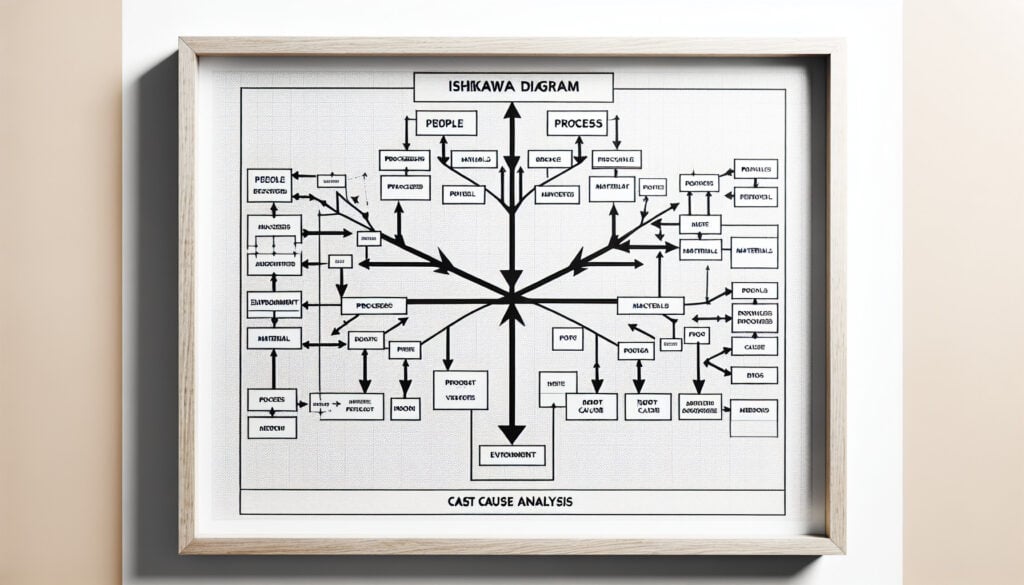A tool for identifying the root causes of a problem.
- Metodologie: Economia, Lean Sigma, Produzione, Risoluzione dei problemi, Qualità
Ishakawa Diagram

Ishakawa Diagram
- Brainstorming, Miglioramento continuo, Produzione snella, Tecniche di risoluzione dei problemi, Miglioramento dei processi, Gestione della qualità, Analisi della causa principale, Sei Sigma
Obiettivo:
Come si usa:
- Also known as a fishbone diagram or cause-and-effect diagram, it is a visualization tool for categorizing the potential causes of a problem in order to identify its root causes. The causes are typically grouped into major categories, such as people, methods, machines, materials, measurements, and environment.
Professionisti
- Simple and easy to understand; Helps to identify the root causes of a problem and not just the symptoms.
Contro
- Can be subjective and depend on the knowledge of the participants; May not be suitable for complex problems with multiple causes.
Categorie:
- Risoluzione dei problemi, Qualità
Ideale per:
- Identifying the root causes of a problem in a team brainstorming session.
The Ishikawa Diagram is widely utilized in various industries such as manufacturing, healthcare, software development, and service sectors, serving as an effective tool during phases of problem-solving or quality improvement initiatives. Typically employed in team brainstorming sessions, this methodology draws participation from diverse stakeholders including engineers, quality assurance personnel, project managers, and frontline employees, enabling a comprehensive examination of issues from multiple angles. Each category within the diagram, such as people, processes, machinery, materials, measurements, and environment, encourages participants to think critically about all potential causes that could contribute to a problem, facilitating a systematic approach to identifying root causes rather than just addressing surface-level symptoms. With its straightforward visual format, the diagram promotes collaborative discussions and enhances understanding among team members, making it easier to communicate complex issues and fostering a shared commitment to developing actionable solutions. Industries often apply this methodology in contexts like Six Sigma projects or Lean initiatives, where continuous improvement is crucial, demonstrating its versatilità across different project types and goals. In practice, this tool can lead to more sustainable outcomes by encouraging teams to implement corrective measures that tackle the actual underlying issues rather than simply providing temporary fixes. Engaging in this exercise not only aids in troubleshooting but also strengthens the team’s problem-solving capabilities for future challenges.
Fasi chiave di questa metodologia
- Define the problem clearly and concisely.
- Draw the fishbone diagram with a horizontal line and a box at the end for the problem statement.
- Identify main categories of causes and add them as branches off the spine of the diagram.
- Brainstorm potential causes within each category and add them as sub-branches.
- Analyze the most significant causes by discussing their potential impact and likelihood.
- Select the root causes for further investigation or action.
- Develop action plans to address the identified root causes.
Suggerimenti per i professionisti
- Involve cross-functional teams to bring diverse perspectives, enhancing the depth of analysis and uncovering hidden causes.
- Regularly review and update the diagram as new data emerges, ensuring that it reflects the current understanding of the problem.
- Utilize digital tools for real-time collaboration, allowing team members to contribute insights asynchronously, thus enriching the discussion.
Leggere e confrontare diverse metodologie, raccomandiamo il
> Ampio archivio di metodologie <
insieme ad altre 400 metodologie.
I vostri commenti su questa metodologia o ulteriori informazioni sono benvenuti su sezione commenti qui sotto ↓ , così come tutte le idee o i link relativi all'ingegneria.
Contesto storico
1962
1970
1972
1980
1980
1986
1986
1960
1963
1970
1980
1980
1980
1986
1987
(se la data non è nota o non è rilevante, ad esempio "meccanica dei fluidi", viene fornita una stima approssimativa della sua notevole comparsa)















Post correlati
Calcolatore da METS a calorie
Meta-analisi
Mappatura dei messaggi
Diagrammi del modello mentale
Forze di spinta e di trazione massime accettabili
Pianificazione dei fabbisogni di materiale (MRP)